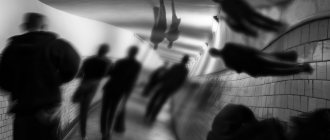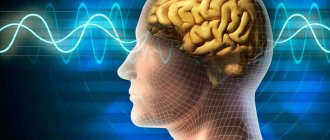In the scientific community, schizophrenia refers to a complex personality disorder at the psychological level, leading to disturbances in emotional reflexes and mental abilities. According to official statistics, 1% of people suffer from this disease, not counting those who are not aware of the problem. Treatment of schizophrenia is aimed at relieving acute symptoms, which gives the person a chance to return to normal life. But most people treat such patients with prejudice and negativity, which has given rise to many myths in this direction. They are baseless, but firmly rooted in the consciousness of the people.
Schizophrenics are dangerous to society due to cruelty and aggressiveness
This is also partly a myth. Many people have the impression that people with schizophrenia pose a threat to others. Mostly this is the negative influence of media and films. In fact, people with schizophrenia are as harmless as children. On the contrary, they themselves often become targets of criminal attacks.
A different scenario happens in the absence of proper treatment. Then, in the acute stage of the disease, a person is prone to violence under the influence of visions and delusional thoughts. It’s more scary when there are hallucinations of an auditory nature in the form of a call for specific hostile actions.
For example, in 2015, one resident of Nizhny Novgorod, during an exacerbation of schizophrenia, killed his own family (six children, wife and mother). He explained the action by saying that he heard an order to act in this way. Belov suffered from schizophrenia for a long time and repeatedly showed aggression towards his wife. Relatives tried to keep it a secret and did not seek help from doctors.
No less dangerous are delusional states associated with persecution mania. A person sees everyone and everything around him as a threat to himself. To protect himself, he often begins to defend himself from supposedly attacking people. Therefore, during an exacerbation of schizophrenia, relatives close to the patient are at greater risk.
Variants of the course of the disease
Schizophrenia can occur in several forms:
- continuous;
- paroxysmal;
- paroxysmal-progressive or fur coat-like.
The continuously ongoing form of the disease is the richest in symptoms. During its course, both negative and positive signs are shared. This form of the disease is characterized by a continuous, progressive course. In her clinical picture, periods of symptomatic outbreaks alternate with calmer phases, but in this case there is no talk of remission.
The continuous form of the disorder is expressed in 3 variants:
- low-grade schizophrenia;
- paranoid schizophrenia;
- malignant schizophrenia.
Sluggish schizophrenia is considered the most favorable type of disorder. During its course, negative symptoms predominate and in most cases do not lead to a deep disintegration of the personality. Productive symptoms include phobias, obsessive thoughts, hysteria, and depersonalization. It manifests itself in the form of a calm, mildly expressed constant course, with periodically occurring attack periods.
Phobias and obsessions very often form the basis of a sluggish form of schizophrenia. The former can be of a varied nature:
- fear of moving in transport;
- exposure to external hazardous factors - poisons, chemically hazardous substances, pathogens, piercing objects;
- fear of helplessness;
- fear of madness.
Anxiety in schizophrenia is a frequent accompaniment of the disorder, leading to the formation of anxious-phobic states. These are, first of all, panic attacks, characterized by specificity and illogical manifestations. Among them, a generalized fear of harming oneself and others dominates. The patient has a concentrated panic fear that he might kill someone, steal someone else's child, or jump out of a window. Fear is exaggerated, accompanied by vivid images of the imagination, which further complicates the situation.
Panic attacks are also accompanied by somatovegetative disorders in the form of unusual sensations in the body, the appearance of severe weakness, and incorrect perception of the structure of one’s body. Inappropriate sensations arise such as “someone is squeezing the heart inside into a fist”, “a corrosive mixture has been poured into the stomach.” On this basis, phobias such as fear of developing a heart attack or stroke are produced.
A 38-year-old woman was walking down the street and suddenly felt a strong blow to her head. After this, a feeling of compression was formed that moved in the brain. She was afraid that she was about to be paralyzed: she seemed numb, she couldn’t even say anything. It seemed to her that she was being divided into two parts. At the same time, she was conscious, the ability to move was preserved, but she did not feel her movements. Soon it was all over.
Upon arrival at the psychiatric hospital, it turned out that the patient was suffering from an obsessive conspiracy thought: all the people she meets on the street, her colleagues at work, are watching her and constantly discussing her.
In the hospital, the patient had a headache all the time. The sensations were different: sometimes it was stuffed with cotton wool, sometimes only one half of the brain was working, it was pulsating and protruding from the skull. She was lethargic, gloomy, constantly lying down, all the time focusing on her feelings. She believed that she had brain cancer, but tests disproved this theory. She showed increased concern about her health. She was rude and mocked the staff.
In addition to phobias, the patient develops obsessions. Among them is the desire for cleanliness and absolute order. An invincible desire appears to put everything in its place, but not in the usual form, but with a manic absolute. If towels are folded in a closet, then this is done as if under a ruler, and when one edge gets out of line, the patient strives to quickly fix it. Everything in his house is arranged with amazing precision, sorted by color and size. And most importantly: it is unacceptable to violate the established order.
Other pathological thoughts are inspired by the cleanliness of one's clothes and body. A person constantly thinks that his clothes are dirty, although there is no reason for this.
Another common group of obsessions is constant doubts. The patient torments himself with thoughts that he is seriously ill. Constant doubts creep into his mind about the actions he has taken, some of the most common: did I turn off the gas, the iron, or locked the apartment. Gradually such doubts become more widespread. They arise in connection with events that have not yet happened or acquire a completely pathological character: the patient begins to doubt whether he has killed someone or whether he is involved in some illegal acts. Gradually the obsessions become more and more ridiculous.
Then fears and obsessions lose their primacy, being replaced by rituals, they come to the fore in the picture of the disorder. If a person is concerned about his health, he regularly visits doctors. In the case of obsessive cleanliness, he systematically “brings” his clothes to shine: cleanses imaginary dirt.
Ritual actions in the process of their development turn into stereotypical, subconscious repetitions. During the manifestation of the disorder, the patient may harm himself: pulling out hair, piercing the skin, squeezing in the eyes. These features distinguish this form of schizophrenia from obsessive-compulsive disorder.
A little more about low-grade schizophrenia
Another sign of low-grade schizophrenia is depersonalization. It manifests itself as a total emotional breakdown, that is, it affects different aspects of the psyche. The patient loses interest in life, he becomes uninitiative, inactive, passive in his actions and desires.
At the onset of the disease, one may notice hypertrophy and instability of individual feelings and emotions. For example, mood lability, exacerbation of stress reactions, imagination.
A significant symptom is a change in self-perception. The patient notes that he is losing flexibility of thinking, the ability to perceive the world around him fully - it seems somehow unreal, dull. A person may not recognize himself in the mirror.
Attacks of the disease are accompanied by anxious-apathetic depression or panic attacks. In a more favorable period, low mood and dysphoria are observed.
In the prime of the disease, a phenomenon called painful anesthesia appears. This is an emotional vacuum in which a person loses the ability to feel and react to what is happening with the range of emotions given to us by nature. The movie he watched, the story he heard, his loved ones are equally indifferent to him. He feels neither pleasure, nor fear, nor empathy. The world stopped, froze.
There is a gap between the human “I” and reality. The patient loses contact with the past, forgets who he was. The life around him is not interested. He does not understand the relationships between people, what they are needed for.
The culmination of the disease is defective depersonalization - the expression and understanding of one's inferiority, regression of feelings, emotional dullness. Detachment from people is associated with the loss of the ability to establish relationships with another person and make new acquaintances.
Sluggish schizophrenia can develop against the background of psychopathy, most often of the hysteroid or schizoid type. Hysterical VS is expressed in symptoms of hysteria, only exaggerated several times. Hysterical attacks are rude and feigned, with pronounced demonstrativeness and affectation.
Hysterical psychosis, in some cases lasting up to 6 months, is accompanied by a change in consciousness. A person experiences imaginary hallucinations. Over time, they transform into pseudohallucinations - a more persistent and severe form. Excitement gives way to stupor.
Gradually, pathological traits such as adventurism, deceit, meanness, etc. stabilize in the patient’s personality, but at the same time, demonstrativeness and loudness of behavior go away. The appearance of the patients is characteristic: they often turn into tramps, but at the same time they look bright, wearing fancy clothes and an overabundance of cosmetics for women. Such people immediately catch your eye.
The development of the schizoid type of disorder can be traced using the following example. Boy 15 years old. Before the illness he had positive characteristics. Diligent, disciplined, diligent, serious. I played sports and studied well. I was interested in chemistry. Was closed. I didn’t make close friends with anyone, but my relationships with my classmates were smooth.
Changes began to manifest themselves with emotional coldness, especially towards the mother. He began to treat her rudely and shouted at her. He responded to her wishes and feelings with indifference. Stopped doing housework. He locked himself in his room and performed some experiments. Confused day with night.
It became difficult to wake up in the morning and stopped going to school. He completely isolated himself from his classmates and did not leave the house. Previously unacceptable anger, rudeness, and grumpiness developed in his character.
Over time, I stopped taking care of myself. He didn’t brush his teeth, didn’t wash, walked around in dirty underwear. He rejected all his mother’s attempts to talk to him. He demanded that she buy him equipment for his experiments.
The negative symptoms of the sluggish form of the disorder are most widely manifested in symptom-poor schizophrenia, although according to modern nomenclature this form is considered a subtype of schizotypal disorder.
Among its main symptoms are progressive autism and detachment from others. Emotional decline is manifested by inhibition of drives and a decrease in sensory reactions. Other signs include physical inactivity, lethargy, depression of mental and physical activity, and lack of motivation to act.
Mood disorders are usually expressed by depression and hypochondria. Complete immobilization or stupor is not observed, but actions become slow and clumsy. Speech is monotonous.
Such patients are able to take care of themselves independently and even do simple work, but are not adapted to living alone. Requires supervision.
Malignant schizophrenia
The malignant form of continuously ongoing schizophrenia is characterized by rapid progression of the pathological process. Over 3–5 years, irreversible changes in the psyche occur, leading to the formation of a schizophrenic defect.
It appears at a young age, usually before the age of 20, and accounts for 8% of all cases of the disease.
Malignant or grossly progressive schizophrenia can occur in 3 forms:
- simple schizophrenia;
- catatonic;
- hebephrenic.
In the latent period of grossly progressive schizophrenia, schizoid features come to the fore. This is an emotional stupor, when emotions become dull and the sensory response becomes monotonous, without impressions and expressiveness.
Activity and ability to work decrease, interest in previously significant things is lost. The person is apathetic, exhausted. There are some oddities in behavior. Difficulties in communication arise.
During the heyday of the disease, symptoms of one of the types of malignant schizophrenia dominate.
In the simple form, the patient is accompanied by negative signs. Productive symptoms are not typical for simple schizophrenia.
The main symptoms are apathy, lack of will and blurred emotional reactions. Ridiculous hobbies appear in the form of collecting useless things and designing unnecessary inventions.
A typical phenomenon is metaphysical intoxication. The patient shows interest in psychological, philosophical, and theological topics. He begins to analyze everything that happens in the world, but in the form of fruitless philosophizing, detached from reality, and not subject to any criticism. It resists the logic we are accustomed to. As a result, it turns out that the person spews illogical conclusions. They are vague and unstable, but the patient is confident that they are right and does not try to convince anyone or win anyone over to his side.
His statements are filled with terms, scientific expressions, abstract concepts, but they are not connected in meaning. For example, to the question: what is a head, the patient answers: it is a part of the body without which it is simply impossible to live. It is possible without an arm or leg, but without a head it is undesirable. This is the power of the body, in it lies the brain - the brain of the body.
In adolescents, who more often than others struggle with a simple form of schizophrenia, the disease can manifest itself as an inversion of character traits. So, a calm, obedient, good-natured teenager suddenly begins to show aggressiveness and cruelty. He is rude, rude, cold, indifferent, and aggressive towards loved ones.
Such patients are inactive and can lie on the couch all day. Children skip school, become members of gangs, and run away from home. They ignore basic rules of self-care.
Simple schizophrenia quite quickly causes the development of complete lack of will and apathy, loss of vital energy, and impaired speech.
A patient with hebephrenic schizophrenia can be characterized as having relapsed into childhood. The name of the disease comes from the name of the ancient Greek goddess of youth, Hebe. An adult behaves like a child. Fooling around, running, jumping, making faces.
The behavior of such patients is pretentious and unpredictable, characterized by spontaneity and aimlessness. Patients are having fun, giggling, grimacing, and taking unnatural poses. Causeless fun quickly gives way to crying and depressed mood.
The activity is characterized by primitivism. Thus, a teenager suffering from hebephrenic schizophrenia, tired of waiting for the restroom to be free, shit in his shoe. And then he tied him to the lamp.
Speech is incoherent and devoid of logic. Patients use foul language or, on the contrary, lisp.
Such people cause fear and hostility among those around them. When asked to stop this behavior, patients increase its intensity or show aggression.
The disease progresses quickly, and at the end of the process, complete indifference and inactivity sets in. A person cannot cope with basic tasks and serve himself.
Catatonic schizophrenia manifests itself by alternating phases of stupor and excitement. Catatonic stupor is characterized by freezing in one position, often of an absurd nature. Such patients are characterized by waxy flexibility - they retain any position given to them. Catalepsy occurs when a part of the body remains in one position. For example, if you raise the patient's hand and then release it, it will freeze in the raised position.
In this state, a person isolates himself from others. Does not respond to speech addressed to him, does not respond to any impulses.
Stupor suddenly gives way to excitement. Stereotyped movements are noted; patients can copy the actions and speech of other people. They run, dance, have fun, take mannered poses. Mood is subject to sudden changes: from low, depressed to high, sometimes aggressive. Active and paradoxical negativism is observed when a person either refuses to fulfill a request directed to him or does the opposite.
The clinical picture is supplemented by the phenomena of depersonalization and derealization, delusions and hallucinations.
Here is a description of how a patient behaved in a psychiatric hospital at the moment of catatonic excitement: “He constantly talks and swears. Aggressive towards patients and staff. Lying on the bed, he knocks on it with his feet, then jumps up and hits his forehead on the floor. He runs out of the room, banging on all the doors. Not sleeping. Running up to the patients, he hits them on the back with his fist. He cannot sit still and falls to the floor. She listens to something, says that she is being followed, threatens to shoot someone. She claims that everything around is saturated with current, she will be destroyed.”
Catatonic excitement is accompanied by an oneiric state, when patients become direct participants in fantastic pictures of their imagination: the end of the world, the arrival of aliens, the invasion of dinosaurs. It happens that the process is reinforced by an increase in temperature, the appearance of bruises on the body, and symptoms of exhaustion.
Upon recovery from the state, the patient talks about his fantastic adventure in bright colors.
Paroxysmal schizophrenia
This form of the disease, in contrast to the continuously ongoing one, is distinguished by the occurrence of schizophrenic attacks that develop within 2 days and last a couple of weeks.
Before the attack begins, the patient feels inexplicable anxiety and confusion. There is a feeling that he does not understand the essence of what is happening around him. Sleep is disturbed, the person suffers from insomnia. Mood instability is also a typical symptom. Joy and fun suddenly give way to crying and apathy.
The attacking period is characterized by the appearance of hallucinations and delusional ideas. Hallucinatory decoys are often auditory: voices typical of schizophrenia, threatening, commenting, guiding. There are also olfactory hallucinations with an interesting characteristic: a yellow smell, the smell of an earthen mound.
Delusional ideas are not persistent and constant. They are episodic and situational. For example, if a doctor listens to a patient with a phonendoscope, then he gets the idea that the doctor is eavesdropping on his thoughts.
Delusions of staging are common. A patient, entering a store and seeing a crowd of people in it, mistakes it for a secret society.
Usually the attack goes away even without treatment. On average, the interictal period is up to 3 years. But different variants of the course of the disease are possible, in which the frequency of relapses and their intensity changes.
A favorable factor that helps reduce the frequency of attacks is the patient’s age. A milder course is observed in patients over 30 years of age. In this case, the cause of exacerbation becomes provoking factors, psychogenic or somatic. Manifestations of the disease are mild in nature, and periods of remission last more than three years. There is a possibility of forming longer remissions.
Schizophrenia can develop due to flaws in upbringing
One of the causes of schizophrenia is considered to be improper upbringing. In particular, we are talking about a lack of attention from the mother. In fact, blaming parents in this matter is baseless. No matter how coldly they treat their own child, this cannot provoke illness years later. Schizophrenia is a serious mental disorder, the development of which is caused by a whole complex of negative factors. Here are some of them:
- predisposition at the genetic level;
- head injuries;
- frequent stressful situations;
- brain dysfunction and so on.
There are still many questions in this regard to which scientists have not received accurate answers.
Depression
Depression
is a fairly common mental illness characterized by negative thinking, low mood, apathy and fatigue. Residents in a big city often have to live in chronic stress, and psychological trauma is also not uncommon.
Symptoms
- Dissatisfaction with one's lot in life.
- Feelings of loneliness, rejection, uselessness.
- Guilt.
- Poor concentration.
- Increased irritability.
- Aggression for no reason.
- Excessive appetite or, conversely, lack thereof.
- Anxiety about the future.
- Lack of desire to communicate with people.
- Lack of interest in surrounding events.
- In severe cases - thoughts of death and suicide.
- At the physical level, it manifests itself as pain in the gastrointestinal tract, heart and muscles, chest compression, inhibited reactions and slow speech.
Causes
- Constant stress.
- Psychological trauma.
- Genetics.
- Endocrine diseases, hormonal imbalance.
- Diseases of the central nervous system.
- Concomitant chronic diseases.
- Living in a big city with a high population density.
- Sedentary lifestyle.
- Unbalanced diet.
- Violation of the daily routine.
- Alcoholism and drug addiction.
- Side effect after taking the drug.
If one of the parents suffers from schizophrenia, the child cannot avoid a similar fate
It is believed that parents with schizophrenia give birth to a mentally ill child. This statement is fundamentally incorrect. Heredity cannot be ruled out, but it is not the disease that is transmitted, but the tendency to it. Therefore, it is wrong to give up on a child whose mother and father or one of them suffers from schizophrenia.
The theoretical probability of inheriting the disease is estimated at 67-88%. But in reality the numbers are not so scary:
- in identical twins (even those with a genetic predisposition) - 45-47%;
- Mom or dad is sick - 14%, both - 45%;
- the diagnosis was made to close relatives – about 5%.
Various types of research continue to establish the degree of inheritance of schizophrenia. But so far the results are mixed and preliminary. Scientists already know specific genes that can trigger the development of the disease. This is revealed by reading genetic information and carefully studying it.
More precise data were obtained by trying to link this disease to changes in the gene component of several candidates. Thus, the majority of schizophrenics have a polyform type of serotonin, dopamine and COMT genes. But their presence can also be associated with other mental disorders. So, even if there is a complete breakdown of the genotype, it is impossible to give an accurate forecast of whether a person will develop schizophrenia or not.
Treatment programs
Treatment of depression
Panic attacks
Treatment of schizophrenia
Neuroses, phobias
Schizophrenia leads to dementia
In life, you can encounter different clinical variants of the development of schizophrenia. Each case is individual. In some, the development of schizophrenia is practically asymptomatic and does not in any way affect mental capabilities. Such patients are still able to think rationally, learn successfully, and do not suffer from memory loss and other manifestations characteristic of schizophrenia.
Other people with a similar diagnosis show obvious deviations at the emotional and mental level. With each new attack, the situation worsens and over time leads to the fact that the person is unable to independently perform basic everyday activities, much less work. There are especially severe forms when the disease progresses rapidly and quickly leads to disability.
No doctor can say for sure what awaits a person with schizophrenia. Despite numerous studies in this direction, science is still powerless. You can compare the state of the brain at different time stages, based on which you can make an approximate forecast.
Cases have been recorded where people suffering from schizophrenia for a long time remain completely adequate and do not lose basic life skills. For example, Nobel laureate D.F. Nash was schizophrenic. But this did not stop him from successfully teaching at the university.
Psychiatrist consultation
24-hour telephone number to contact the doctor on duty: 8 (831) 266-03-06.
Any request for medical help is a medical confidentiality and cannot be disclosed.
Anonymity guaranteed!
Chronic fatigue syndrome
Chronic fatigue syndrome
(CFS) is a disease characterized by prolonged fatigue that does not go away even after prolonged rest.
Symptoms
A patient with CFS is characterized by irritability; the patient experiences irritability, fatigue, lethargy, and apathy. Patients suffer from insomnia, and many have difficulties with short-term memory.
Causes
- Increased stress that haunts a person at work every day. High levels of stress provoke hormonal imbalance and deplete the nervous system.
- Unhealthy lifestyle: lack of sleep, rare walks in the fresh air and infrequent exercise provoke a decrease in immunity and susceptibility to viral infections. Residents of megacities sleep little due to their busy schedules, work a lot, and rarely get to relax in nature, which results in a lack of physical activity.
- Chronic diseases of internal organs that have a long course overload the nervous system.
- Improper nutrition leads to disruption of the body's metabolism.
- Viruses and infections provoke the development of CFS.
With this diagnosis, you need to take medications for the rest of your life.
So far, the only effective way to combat schizophrenia is medication. During consultation with a psychiatrist, a treatment regimen is developed for each patient based on the use of appropriate psychotropic medications. After completing the prescribed course, the doctor assesses the patient’s condition and may allow a break. If favorable dynamics are observed after this, the doctor stops the medications.
Schizophrenia is a difficult test for a person. For such patients, outside support is important, and the myths that have taken root among people about this disease only complicate everything. Therefore, upon learning of the diagnosis, many become severely depressed and begin to think about suicide. Only professional help will help such patients adequately recognize the problem and set them up for recovery, since schizophrenia is treatable.
Make an appointment










